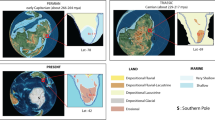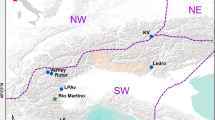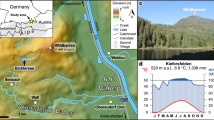Abstract
STABLE-ISOTOPE ratios of carbon in soils or lake sediments1–3 and of oxygen and hydrogen in peats4,5 have been found to reflect past moisture variations and hence to provide valuable palaeoclimate records. Previous applications of the technique to peat have been restricted to temperate regions, largely because tropical climate variations are less pronounced, making them harder to resolve. Here we present a δ13C record spanning the past 20 kyr from peats in the Nilgiri hills, southern India. Because the site is at high altitude (>2,000 m above sea level), it is possible to resolve a clear climate signal. We observe the key climate shifts that are already known to have occurred during the last glacial maximum (18 kyr ago) and the subsequent deglaciation. In addition, we observe an arid phase from 6 to 3.5 kyr ago, and a short, wet phase about 600 years ago. The latter appears to correspond to the Mediaeval Warm Period, which previously was believed to be confined to Europe and North America6,7. Our results therefore suggest that this event may have extended over the entire Northern Hemisphere.
This is a preview of subscription content, access via your institution
Access options
Subscribe to this journal
Receive 51 print issues and online access
$199.00 per year
only $3.90 per issue
Buy this article
- Purchase on Springer Link
- Instant access to full article PDF
Prices may be subject to local taxes which are calculated during checkout
Similar content being viewed by others
References
Krishnamurthy, R. V., Bhattacharya, S. K. & Kusumgar, S. Nature 341, 150–152 (1986).
Cerling, T. E., Quade, J., Wang, Y. & Bowman, J. R. Nature 341, 138–139 (1989).
Ambrose, S. H. & Sikes, N. E. Science 253, 1402–1405 (1991).
Brenninkmeijer, C. A. M., van Geel, B. & Mook, W. G. Earth Planet. Sci. Lett. 61, 283–290 (1982).
Dupont, L. M. & Mook, W. G. Chem. Geol. (Isotope Geosci. Sect.) 66, 323–333 (1987).
Gribbin, J. & Lamb, H. H. in Climatic Change (ed. Gribbin, J.) 68–82 (Cambridge Univ. Press, 1978).
Crowley, T. J. & North, G. Palaeoclimatology (Oxford Univ. Press, New York, 1991).
Smith, B. N. & Epstein, S. Plant Physiol. 47, 380–384 (1971).
Tieszen, L. L., Senyimba, M. M., Imbamba, S. K. & Troughton, J. H. Oecologia (Berlin) 37, 337–350 (1979).
Korner, Ch., Farquhar, G. D. & Roksandic, Z. Oecologia (Berlin) 74, 623–632 (1988).
Blasco, F. Montagnes du Sud de I'lnde (Institut Français, Pondicherry, 1971).
Meher-Homji, V. M. Indian geogrl. J. 59, 205–213 (1984).
Von Lengerke, H. J. The Nilgiri—Climate and Weather of a Mountain Area in South India (Steiner, Weisbaden, 1977).
Gates, W. L. Science 191, 1138–1144 (1976).
Manabe, S. & Hahn, D. G. J. geophys. Res. 82, 3889–3911 (1977).
Prell, W. L. & Kutzbach, J. E. J. geophys. Res. 92, 8411–8425 (1987).
Rajagopalan, G., Vishnu-Mittre & Sekar, B. Radiocarbon 20, 398–404 (1978).
Rajagopalan, G., Vishnu-Mittre & Sekar, B. Radiocarbon 22, 54–60 (1980).
Rajagopalan, G., Vishnu-Mittre, Sekar, B. & Mandal, T. K. Radiocarbon 24, 45–53 (1982).
Vasanthy, G. Rev. Palaeobot. Palynol. 55, 175–192 (1988).
Stuiver, M. & Kra, R. S. (eds) Proc. Twelfth int. Radiocarbon Conf. (Trondheim, Norway): published as Radiocarbon 28, 805–1030 (1986).
Bard, E., Hamelin, B., Fairbanks, R. G. & Zindler, A. Nature 345, 405–410 (1990).
Singh, G., Wasson, R. J. & Agrawal, D. P. Rev. Palaeobot. Palynol. 64, 351–358 (1990).
Van Campo, E., Duplessy, J. C. & Rossignol-Strick, M. Nature 296, 56–59 (1982).
Van Campo, E. Quat. Res. 26, 376–388 (1988).
Duplessy, J. C. Nature 295, 494–498 (1982).
Sarkar, A., Ramesh, R., Bhattacharya, S. K. & Rajagopalan, G. Nature 343, 549–551 (1990).
Swain, A. M., Kutzbach, J. E. & Hastenrath, S. Quat. Res. 19, 1–17 (1983).
Williams, M. A. J. & Clarke, M. F. Nature 308, 633–635 (1984).
Kutzbach, J. E. Science 214, 59–61 (1981).
Caratini, C., Fontugne, M., Pascal, J. P., Tissot C. & Bentaleb, I. Curr. Sci. 61, 669–672 (1991).
Author information
Authors and Affiliations
Rights and permissions
About this article
Cite this article
Sukumar, R., Ramesh, R., Pant, R. et al. A δ13C record of late Quaternary climate change from tropical peats in southern India. Nature 364, 703–706 (1993). https://doi.org/10.1038/364703a0
Received:
Accepted:
Issue Date:
DOI: https://doi.org/10.1038/364703a0
This article is cited by
-
Predicting tipping points of vegetation resilience as a response to precipitation: Implications for understanding impacts of climate change in India
Biodiversity and Conservation (2024)
-
Geochemical records of tectono-climatic environmental changes in 14C-dated peats from Ziro Valley of Eastern Himalaya, Arunachal Pradesh, India
Arabian Journal of Geosciences (2022)
-
Invasive nitrogen-fixing plants increase nitrogen availability and cycling rates in a montane tropical grassland
Plant Ecology (2022)
-
Can species distribution models and molecular tools help unravel disjunct distribution of Rhododendron arboreum?
Journal of Genetics (2021)
-
Fire differentially affects mortality and seedling regeneration of three woody invaders in forest–grassland mosaics of the southern Western Ghats, India
Biological Invasions (2020)
Comments
By submitting a comment you agree to abide by our Terms and Community Guidelines. If you find something abusive or that does not comply with our terms or guidelines please flag it as inappropriate.



